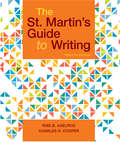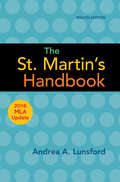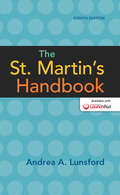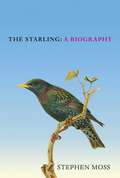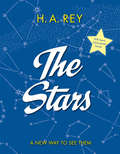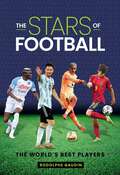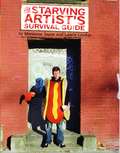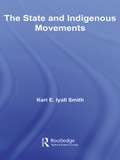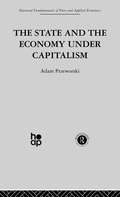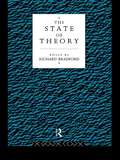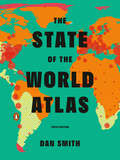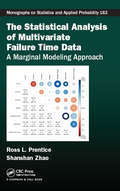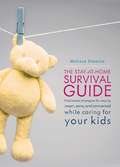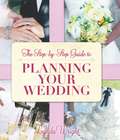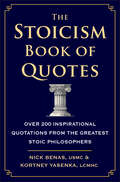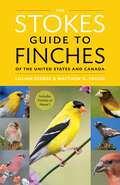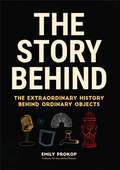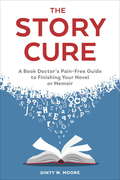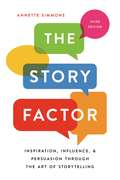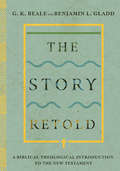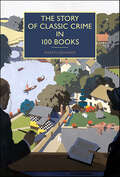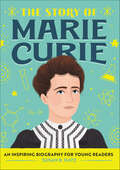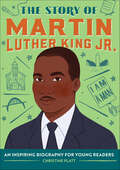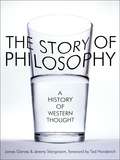- Table View
- List View
The St. Martin’s Guide to Writing (Twelfth Edition)
by Charles R. Cooper Rise AxelrodWhether you have years of teaching experience or are new to the classroom, you and your students can count on The St. Martin’s Guide to Writing to provide the thoroughly class-tested support you need for first-year composition, with a rhetoric, an array of engaging readings, a research manual, and a handbook, all in a single book — and available online in LaunchPad. Thousands of instructors and their students rely on the Guide’s proven approach because it works: Acclaimed step-by-step reading and writing guides to 9 different genres offer sure-fire invention that get students started and revision strategies that help them develop their writing. The new edition continues in its strategies to serve a diverse audience of schools and students with an improved, accessible design, new support for reflection that encourages the transfer, and a new Student’s Companion for students taking co-requisite or ALP courses.
The St. Martin’s Handbook
by Andrea A. LunsfordPACKAGE THIS TITLE WITH OUR 2016 MLA SUPPLEMENT, Documenting Sources in MLA Style (package ISBN-13: 9781319087371). Get the most recent updates on MLA citation in a convenient, 40-page resource based on The MLA Handbook, 8th Edition, with plenty of models. Browse our catalog or contact your representative for a full listing of updated titles and packages, or to request a custom ISBN. Andrea Lunsford's comprehensive advice in The St. Martin's Handbook, Eighth Edition, supports students as they move from informal, social writing to both effective academic writing and to writing that can change the world. Based on Andrea's groundbreaking research on the literacy revolution, this teachable handbook shows students how to reflect on the writing skills they already have and put them to use both in traditional academic work and in multimodal projects like blog posts, websites, and presentations. Integrated advice on U. S. academic genres and language follows best practices for helping students from both international and native-speaker backgrounds improve their understanding of academic English. Throughout The St. Martin's Handbook, Andrea Lunsford encourages all of today's students to learn everything they need to communicate effectively with the diverse people sharing their classrooms, workspaces, and civic lives. See what's in the LaunchPad
The St. Martin’s Handbook
by Andrea A. LunsfordAndrea Lunsford's comprehensive advice in The St. Martin's Handbook, Eighth Edition, supports students as they move from informal, social writing to both effective academic writing and to writing that can change the world. Based on Andrea's groundbreaking research on the literacy revolution, this teachable handbook shows students how to reflect on the writing skills they already have and put them to use both in traditional academic work and in multimodal projects like blog posts, websites, and presentations. Integrated advice on U. S. academic genres and language follows best practices for helping students from both international and native-speaker backgrounds improve their understanding of academic English. Throughout The St. Martin's Handbook, Andrea Lunsford encourages all of today's students to learn everything they need to communicate effectively with the diverse people sharing their classrooms, workspaces, and civic lives.
The Starling: The perfect Christmas gift for bird lovers (The Bird Biography Series)
by Stephen Moss‘Stephen Moss delights once more - lyrical and informative by turns, he conjures - with breathless eloquence - another feathered beauty of our skies.’ Benedict Allen'An engrossing compilation of ornithological tidbits, cultural anecdotes, literary quotes and well chosen historical artwork’ BBC Wildlife, *Books of the Year*Uncover the life of starlings through this beautiful guide to these majestic and gregarious birds from the bestselling author of The Owl, The Robin, The Wren, and The Swan. Even with its exquisite iridescent plumage and magical gift to mimic both human and natural sounds, this common garden bird can often be overlooked. But as they unite in their thousands to display their unique ability to perform dazzling aerial manoeuvres known as murmurations, starlings are nothing short of breathtaking. This is the captivating story of how starlings have shaped our world, from influencing agriculture and inspiring musicians such as Mozart and writers such as Shakespeare, to their impact as an invasive species in North America, South Africa, Australia and New Zealand.With beautiful illustrations throughout, and an expert guide to the most magnificent murmurations in the UK, this eye-opening biography reveals the hidden secrets of one of our most talented and luminous birds.
The Stars
by H. A. ReyThis is a clear, vivid text with charts and maps showing the positions of the constellations the year round.
The Stars of Football: The World's Best 2024 Players
by Rodolphe GaudinThe World's Best PlayersCelebrate the greatest footballers from the world game's current era. The Stars of Football profiles over 90 players, telling the stories of their rise and successes. Fully updated for 2024 with new chapters on the brightest young talent and the game's latest heroes. This modern, fully illustrated book showcases the biggest names to grace the World Cup and other elite competitions. Learn about masters such as Messi and Ronaldo, plus other heroes who continue to enhance their reputations, including Mbappe, Benzema, Lewandowski and De Bruyne. Plus new stars such as Fernandez, Bellingham and Gavi. Full colour packed with action photos. Each player is profiled in a dedicated spread with key statistics and points of interest. All-new cover for 2024 featuring the four biggest stars of the world game.
The Starving Artist's Survival Guide
by Marianne Taylor Laurie Lindop Paul WeilA Blackened Chicken Soup for the Artistic Soul Passion, humiliation, and depravity are the cornerstones of the artistic spirit. How else to rationalize one's deliberate choice to face a life of unsigned rejection letters, calls from worried parents and collection agencies, and cups and cups of ramen noodles? Being a noble artiste is a rough gig. It's one part denial, one part masochism. And it gets all the respect of being a fry cook, without the convenient minimum wage. Only a fool would agree to such soul crushing -- until now. The Starving Artist's Survival Guide boldly reassures both the dreamer and the doer that you are not alone. Regardless of whether you are a painter, a poet, a musician, a writer, an actor, or simply paralyzed by an English lit or fine arts degree, help has arrived. Topics include the pros and cons of various artistic day jobs ("People love clowns, except for the 80 percent who want to beat them up and the 20 percent who do"), coping with form-letter rejections through the healing power of haikus ("You, blinking red light, / A call back from my agent? / No, just goddamn Mom"), a survey of artists' dwellings (from the romanticized loft to Mama's rent-free attic), and most important, "Holding On: Ten Good Reasons to Keep Your Head out of the Oven." Both celebrating and satirizing the pretentious poor, The Starving Artist's Survival Guide recognizes that the best way to cope with self-inflicted poverty is with unbarred humor, not macramé and coupon clipping.
The State and Indigenous Movements (Indigenous Peoples and Politics)
by Keri E. Iyall SmithUsing the comparative historical method, this book looks at the experience of indigenous peoples, specifically the Native Hawaiians, showing how a nation can express culture and citizenship while seeking ways to attain greater sovereignty over territory, culture, and politics.
The State and the Economy Under Capitalism (Fundamentals Of Pure And Applied Economics Ser.)
by A. PrzeworskiFirst published in 2001. Routledge is an imprint of Taylor & Francis, an informa company.
The State of Theory
by Richard BradfordFirst published in 1993. Routledge is an imprint of Taylor & Francis, an informa company.
The State of the World Atlas: Tenth Edition
by Dan SmithThe State of the World Atlas is an accessible, unique visual survey of current events and global trends, highlighting the international scope and complexity of many challenges facing the humanity today. With a bold new design, this distinctive atlas presents the latest statistics on international trade and migration, the globalization of work, aging and new health risks (up to and including the COVID-19 pandemic), food and water, energy resources and consumption, literacy, gender equality, wars and peacekeeping, and more. And for the newest edition, special attention has been brought to the way that all of these issues are affected by the ongoing climate crisis. Fascinating, troubling, and surprising, this is an important resource for anyone who seeks to better understand the world around them.
The Statistical Analysis of Multivariate Failure Time Data: A Marginal Modeling Approach (Chapman & Hall/CRC Monographs on Statistics and Applied Probability #1)
by Shanshan Zhao Ross PrenticeThe Statistical Analysis of Multivariate Failure Time Data: A Marginal Modeling Approach provides an innovative look at methods for the analysis of correlated failure times. The focus is on the use of marginal single and marginal double failure hazard rate estimators for the extraction of regression information. For example, in a context of randomized trial or cohort studies, the results go beyond that obtained by analyzing each failure time outcome in a univariate fashion. The book is addressed to researchers, practitioners, and graduate students, and can be used as a reference or as a graduate course text. Much of the literature on the analysis of censored correlated failure time data uses frailty or copula models to allow for residual dependencies among failure times, given covariates. In contrast, this book provides a detailed account of recently developed methods for the simultaneous estimation of marginal single and dual outcome hazard rate regression parameters, with emphasis on multiplicative (Cox) models. Illustrations are provided of the utility of these methods using Women’s Health Initiative randomized controlled trial data of menopausal hormones and of a low-fat dietary pattern intervention. As byproducts, these methods provide flexible semiparametric estimators of pairwise bivariate survivor functions at specified covariate histories, as well as semiparametric estimators of cross ratio and concordance functions given covariates. The presentation also describes how these innovative methods may extend to handle issues of dependent censorship, missing and mismeasured covariates, and joint modeling of failure times and covariates, setting the stage for additional theoretical and applied developments. This book extends and continues the style of the classic Statistical Analysis of Failure Time Data by Kalbfleisch and Prentice. Ross L. Prentice is Professor of Biostatistics at the Fred Hutchinson Cancer Research Center and University of Washington in Seattle, Washington. He is the recipient of COPSS Presidents and Fisher awards, the AACR Epidemiology/Prevention and Team Science awards, and is a member of the National Academy of Medicine. Shanshan Zhao is a Principal Investigator at the National Institute of Environmental Health Sciences in Research Triangle Park, North Carolina.
The Stay-at-Home Survival Guide: Field-Tested Strategies for Staying Smart, Sane, and Connected When You're Raising Kids at Home
by Melissa StantonMelissa Stanton's The Stay-at-Home Survival Guide is an all-encompassing, truth-telling how-to book that addresses the many practical and psychological issues facing stay-at-home moms today.How do you create time for yourself? Is there really time to do it all (feed the kids, keep them busy, clean the house, balance the checkbook, and take a shower)? How do you deal with the absence of the "professional you"?An invaluable resource for mothers, The Stay-at-Home Survival Guide includes interviews with stay-at-home moms, discussions with experts (family therapists, educators, medical specialists, career counselors), checklists to help you make the most of your time and keep you balanced, and Melissa Stanton's own experiences leaving a career as an editor for People magazine to become a stay-at-home mom herself.
The Step by Step Guide to Planning Your Wedding
by Lynda WrightYour dream wedding starts with this first simple step. Your wedding day marks the beginning of a new and exciting chapter in your life, so you'll want to make sure it's as wonderful as you always dreamed it would be. This book will guide you through all the organisational detail of your wedding preparations so that you'll feel completely confident about the many choices and decisions you will have to make. Written and designed in a logical, easy-to-use style, it concentrates on the practical aspects of preparing for your big day and is divided into three parts: * The Countdown Calendar, detailing all the vital steps at each stage of the preparations * The Action Plans, showing the step-by-step sequences needed to organise the transport, flowers, photography and all the other essentials * The Checklists, providing lots of space for you to record all the relevant information, so that you can track your progress and ensure that nothing has been overlooked If you follow this book step by step, you'll feel confident that your big day will be a great success and one that you'll remember for the rest of your life.
The Step by Step Guide to Planning Your Wedding
by Lynda WrightYour dream wedding starts with this first simple step. Your wedding day marks the beginning of a new and exciting chapter in your life, so you'll want to make sure it's as wonderful as you always dreamed it would be. This book will guide you through all the organisational detail of your wedding preparations so that you'll feel completely confident about the many choices and decisions you will have to make. Written and designed in a logical, easy-to-use style, it concentrates on the practical aspects of preparing for your big day and is divided into three parts: * The Countdown Calendar, detailing all the vital steps at each stage of the preparations * The Action Plans, showing the step-by-step sequences needed to organise the transport, flowers, photography and all the other essentials * The Checklists, providing lots of space for you to record all the relevant information, so that you can track your progress and ensure that nothing has been overlooked If you follow this book step by step, you'll feel confident that your big day will be a great success and one that you'll remember for the rest of your life.
The Stoicism Book of Quotes: Over 200 Inspirational Quotations from the Greatest Stoic Philosophers
by Nick Benas Kortney YasenkaWords of wisdom from the greatest Greek and Roman Stoic philosophers including Seneca, Marcus Aurelius, Diogenes, Epictetus, Plato and more.The Stoicism Book of Quotes compiles over 200 inspirational and illuminating quotations from the world's greatest philosophers. These ancient words come to life in the present and help provide much-needed strength, wisdom, and resilience for all of life's challenges.Stoicism is a school of philosophy that believes virtue is based on knowledge and reason which enables you to rise above your emotions and allows you to control what you can and let go of what you cannot. The Stoic way of thinking allows you to thoughtfully process and accept situations while giving you the power to choose how you react, handle, and cope.Many great leaders and thinkers of our time have sought guidance from Stoic philosophy, including George Washington, Immanuel Kant, Walt Whitman and Theodore Roosevelt, to name a few.For many, Stoicism is a tool in the pursuit of self-mastery, perseverance and wisdom. Living a more stoic life will give you the opportunity to live a mentally healthier, more balanced and overall happier life.
The Stokes Guide to Finches of the United States and Canada
by Lillian Q. Stokes Matthew A. YoungLearn all you need to know about identifying and attracting finches with this comprehensive, gloriously colorful field guide from America&’s foremost authorities on birds and nature. Following the extraordinary finch superflight of 2020-2021, birders across the country became obsessed with finches. With The Stokes Guide to Finches of the United States and Canada, you can gain expert knowledge on these beautiful birds and bring them into your own yard. This fully illustrated guide tells you all you need to know about attracting, observing, and protecting finches. The book also includes: A special section on endangered Hawaiian honeycreeper finches, plus other rare and vagrant species Detailed identification information on each finch species&’ plumages, subspecies, and voice The most complete and up-to-date range maps, including maps of core occurrence and irruption ranges for all red crossbill call types, which have never before been published in a guide Complete life history information Scientific studies on finch migrations and conservation More than 345 stunning full-color photographs and over 50 range maps covering 43 species
The Story Behind: The Extraordinary History Behind Ordinary Objects (Story Behind Ser.)
by Emily ProkopLearn the fascinating history and trivia behind the everyday items we take for granted—from the host of the popular podcast The Story Behind. Many of us learn about the major inventions that shape our world. But we too often overlook the objects we use every day. In The Story Behind, Emily Prokop, creator of the Webby Award nominated podcast, explores the who, how, and huh? of everything from Band-Aids to bubble gum; hypnosis to Hula Hoops; and lullabies to lead pipes. Along the way, she demonstrates how the major events of history—from wars, plagues, and revolutions to historic achievements and discoveries—have influenced some of the world&’s most pervasive inventions. Revealing fascinating new details on topics covered in the podcast, the book also explores many new subjects. Learn how lollipops got started in ancient Egypt, how Kevlar came to be, and why Comic Sans was created. Learn the torture device origins of certain exercise equipment and how some musical instruments were first developed for espionage. From food, fashion, and games to transit and modern technology, The Story Behind offers a closer look at the things closest to us.
The Story Cure: A Book Doctor's Pain-Free Guide to Finishing Your Novel or Memoir
by Dinty W. MooreA collection of cures for writer's block, plotting and characterization issues, and other ailments writers face when completing a novel or memoir, prescribed by the director of creative writing at Ohio University.People want to write the book they know is inside of them, but they run into stumbling blocks that trouble everyone from beginners to seasoned writers. Drawing on his years of teaching at both the university level and at writing workshops across the country, Professor Dinty W. Moore dons his book-doctor hat to present an authoritative guide to curing the issues that truly plague writers atall levels. His hard-hitting handbook provides inspiring solutions for diagnoses such as character anemia, flat plot, and silent voice, and is peppered with flashes of Moore's signature wit and unique take on the writing life.
The Story Factor: Inspiration, Influence, and Persuasion through the Art of Storytelling
by Annette SimmonsFully revised, updated, and expanded, this modern classic will teach you to use the art of storytelling to persuade, motivate, and inspire in life and business Anyone seeking to influence others must first know their own story, and how to tell it properly. Whether you're proposing a risky new venture, trying to close a deal, or leading a charge against injustice, you have a story to tell. Tell it well and you will create a shared experience with your listeners that can have profound results.In this modern classic, Annette Simmons reminds us that the oldest tool of influence is also the most powerful. Fully revised and updated to account for new technology and social media, along with two new chapters on the role of stories in the development of civilization and how to adjust your story to your specific goal, Simmons showcases over a hundred examples of effective storytelling drawn from the front lines of business and government, as well as myths, fables, and parables from around the world. Whether writing a screenplay, or announcing a corporate reorganization, Simmons illustrates how story can be used in ways that cold facts, bullet points, and directives can't. These stories, combined with practical storytelling techniques, show anyone how to become a more effective communicator and achieve their goals.
The Story Retold: A Biblical-Theological Introduction to the New Testament
by G. K. Beale Benjamin L. GladdisThe Story Retold
The Story of Classic Crime in 100 Books
by Martin Edwards&“This is an exemplary reference book sure to lead readers to gems of mystery and detective fiction.&” —Publishers Weekly, starred review This book tells the story of crime fiction published during the first half of the twentieth century. The diversity of this much-loved genre is breathtaking, and so much greater than many critics have suggested. To illustrate this, the leading expert on classic crime discusses one hundred books ranging from The Hound of the Baskervilles to Strangers on a Train which highlight the entertaining plots, the literary achievements, and the social significance of vintage crime fiction. This book serves as a companion to the acclaimed British Library Crime Classics series but it tells a very diverse story. It presents the development of crime fiction—from Sherlock Holmes to the end of the golden age—in an accessible, informative and engaging style. Readers who enjoy classic crime will make fascinating discoveries and learn about forgotten gems as well as bestselling authors. Even the most widely read connoisseurs will find books (and trivia) with which they are unfamiliar—as well as unexpected choices to debate. Classic crime is a richly varied and deeply pleasurable genre that is enjoying a world-wide renaissance as dozens of neglected novels and stories are resurrected for modern readers to enjoy. The overriding aim of this book is to provide a launch point that enables readers to embark on their own voyages of discovery.
The Story of Marie Curie: An Inspiring Biography for Young Readers (The Story of Biographies)
by Susan B. KatzDiscover the life of Marie Curie—a story for kids 6 to 9 about discovering big things through hard workMarie Curie was one of the most celebrated scientists in history. Before she changed the world with her discoveries in physics and chemistry, Marie was an intelligent girl who studied hard to reach the top of her class in school. She overcame many challenges, including people who told her she couldn't be a scientist because she was a woman. She didn't let anything stop her, and her important research is still helping people today. Explore how Marie Curie went from being a young girl growing up in Poland to a famous, Nobel Prize-winning scientist.Independent reading—This Marie Curie biography is broken down into short chapters and simple language so kids 6 to 9 can read and learn on their own.Critical thinking—Kids will learn the Who, What, Where, When, Why, and How of Marie's life, find definitions of new words, discussion questions, and more.A lasting legacy—Find out how Marie Curie helped change the way we understand the world.How will Marie's determination and curiosity inspire you?Discover activists, artists, athletes, and more from across history with the rest of the Story Of series, including famous figures like: Malala Yousafzai, Selena Quintanilla, Frida Kahlo, Helen Keller, and Jane Goodall.
The Story of Martin Luther King Jr.: An Inspiring Biography for Young Readers (The Story Of)
by Christine PlattDiscover the life of Martin Luther King Jr.—a story about standing up for civil rights for kids ages 6 to 9Martin Luther King Jr. became one of the most important civil rights leaders in America by fighting for equality for Black people. Before he made history with his powerful speeches and peaceful protests, Martin was a dedicated, smart kid who loved to learn. He challenged racism and overcame hardships to follow his passion and do the right thing. Explore how Martin went from being a kid with a dream to an outstanding leader who made America a better place for everyone.Independent reading—This Martin Luther King Jr. biography is broken down into short chapters and simple language so kids 6 to 9 can read and learn on their own.Critical thinking—Kids will learn the Who, What, Where, When, Why, and How of Martin's life, find definitions of new words, discussion questions, and more.A lasting legacy—Find out how Martin made the world a more equal place for future generations in this African American history book for kids.How will Martin Luther King Jr.'s life inspire you?Discover activists, artists, athletes, and more from across history with the rest of The Story Of series, including famous figures like Ella Fitzgerald, Simone Biles, Sojourner Truth, Barack Obama, and John Lewis.
The Story of Philosophy
by Jeremy Stangroom James GarveyThe Story of Philosophy sees philosophy for what it is: a passionate, exhilarating quest for human understanding that cannot be reduced to dry categories or simple definitions. Accessible writing, brilliant scholarship and over 150 colour illustrations combine to form a richly informative and highly entertaining work of narrative history.Packed with intriguing anecdotes and fascinating detail, James Garvey and Jeremy Stangroom bring us face to face with the most important philosophers in western history. The story begins with the Ancient Greeks, Socrates, Plato and Aristotle, great thinkers who set the philosophical agenda to this day. It continues with Greek and Roman philosophers--slaves and emperors who found consolation in deep thoughts about life and death--and moves on to the religious thinkers of the Middle Ages. The origins of modern science, politics, and morality are examined, alongside theories of knowledge, logic, mind and matter. Along the way, you'll discover Descartes' evil demon, Locke on the limits of knowledge, Rousseau and Hobbes on human nature, Hume's scepticism, Kant on duty, Nietzsche's Superman, Marx on class struggle, Russell's logic, Wittgenstein on meaning, Sartre on bad faith, Foucault's take on power, and much more.Rigorous, refreshingly free of academic jargon, and highly accessible, this is the ideal introduction for anyone who wants to gain a new perspective on philosophy's deepest mysteries and most intriguing discoveries.
